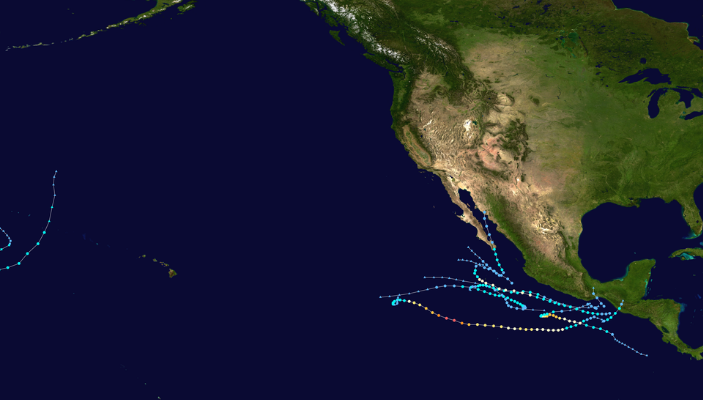Hurricane Erick 2025 has drawn attention across meteorological centers due to its rapid formation and trajectory across the Pacific basin. This weather system, categorized as a tropical cyclone, is being closely monitored by the National Hurricane Center (NHC) for its potential effects on coastal communities and maritime zones.
This article offers a people-first overview: how Erick formed, what its expected path looks like, how it compares to past storms, and what steps individuals and communities should take to remain safe and informed.
Formation and Classification of Erick
Meteorological Background
Hurricane Erick originated from a low-pressure system that developed near the Eastern Pacific in late June. Favorable sea surface temperatures above 80°F (27°C), low vertical wind shear, and moist atmospheric conditions provided an ideal environment for tropical intensification.
By the time it was named Erick, the system had reached sustained winds exceeding 74 mph (119 km/h), qualifying it as a Category 1 hurricane on the Saffir-Simpson scale.
Key Classification Stats (as of June 18, 2025):
- Category: 1
- Wind Speed: 80 mph (130 km/h)
- Pressure: 988 mb
- Forward Speed: 12 mph (19 km/h) west-northwest
- Location: Approximately 400 miles south-southeast of Hawaii
Forecast Path and Projected Movement
Tracking the System
As of the latest advisories, Erick is forecast to remain over open waters for most of its lifespan. Meteorologists predict a west-northwest path with minor deviations based on high-pressure ridges and low-level atmospheric steering.
While it is not expected to make direct landfall, tropical storm-force winds, large swells, and possible outer rainbands may impact parts of Hawaii and nearby island chains.
What Influences the Track?
Erick’s movement is being influenced by:
- Subtropical ridges to its north
- Upper-level divergence supporting vertical growth
- Variability in oceanic heat content
Real-time updates from NOAA, NHC, and local agencies remain critical for staying informed.
Potential Impacts: Marine, Coastal, and Inland
Marine Zones
Vessels in the Central Pacific, especially between Hawaii and the Baja Peninsula, may face high swells, rip currents, and gusts reaching gale-force levels. Recreational boating and commercial shipping are advised to exercise caution or adjust routes.
Coastal Risks
Although not projected to make landfall, large waves generated by Erick could cause minor coastal erosion and dangerous surf conditions. Beachgoers in Hawaii, particularly on southern and eastern shores, are urged to follow beach advisories.
Rainfall & Flooding
Outer rainbands could bring intermittent showers to islands in Erick’s outer circulation. Flash flooding remains a low but possible concern in localized zones, especially in valleys and low-lying areas.
Community Preparedness and Individual Safety
What You Can Do
Even when storms don’t make landfall, their peripheral effects can still cause harm. Here’s how communities and individuals can stay safe:
- Monitor official weather alerts (NOAA, NWS, local emergency services)
- Avoid unnecessary coastal travel or water activities
- Prepare for power disruptions if you’re in affected regions
- Check emergency kits (batteries, water, first aid, non-perishables)
Government Response
State emergency agencies have been placed on standby, and Hawaii’s Department of Emergency Management continues to assess conditions. At this time, no evacuations have been issued, but preparedness recommendations are active.
Comparing Erick to Previous Pacific Storms
Historically, hurricanes in the Central Pacific—such as Hurricane Lane (2018) or Hurricane Dora (2023)—have shown how powerful storms can influence regions even without direct landfall.
Erick’s structure, wind bands, and slow movement resemble past systems that brought prolonged coastal conditions like high surf, brief tornadoes, and power outages.
Such comparisons help meteorologists refine predictions and help people better understand risk levels.
Long-Term Outlook and Climate Patterns
Seasonal Outlook for 2025
The 2025 Pacific hurricane season is expected to be above average, influenced by lingering El Niño conditions. Warm water anomalies and a favorable Madden-Julian Oscillation phase suggest more storms like Erick may form this year.
Climate Connection
While no single storm can be blamed directly on climate change, increasing sea surface temperatures and shifting atmospheric patterns contribute to the frequency and intensity of storms globally.
Scientific consensus emphasizes the need for better coastal infrastructure and public awareness.
Staying Informed With Reliable Sources
To make informed decisions, rely on:
- National Hurricane Center (NHC)
- NOAA Pacific Hurricane Central
- Hawaii Emergency Management Agency
- AccuWeather and local meteorological stations
Avoid relying on social media posts unless they are from verified government or scientific accounts.
Summary
Hurricane Erick 2025 may not pose an immediate land threat, but it demonstrates the importance of staying informed, prepared, and cautious even when storms remain offshore. It also serves as a reminder that in a warming world, storms can shift quickly and unpredictably.
Whether you’re a coastal resident, a mariner, or simply someone tracking global weather events, understanding Erick’s path and impact keeps you better positioned to stay safe.
FAQs
1. Is Hurricane Erick 2025 expected to hit land?
No, current forecasts suggest Erick will remain over the Pacific Ocean, though it may bring coastal surf and rain to parts of Hawaii.
2. How strong is Erick right now?
As of the latest update, Erick is a Category 1 hurricane with winds around 80 mph (130 km/h).
3. Should people in Hawaii be concerned?
While a direct hit is unlikely, residents should monitor surf advisories and prepare for minor weather disruptions.
4. How does this compare to past hurricanes?
Erick’s structure is similar to storms like Dora (2023), which caused high surf and localized impacts without landfall.
5. Where can I track Erick’s latest updates?
Visit www.nhc.noaa.gov, or follow local weather services and Hawaii’s emergency channels for real-time updates.




